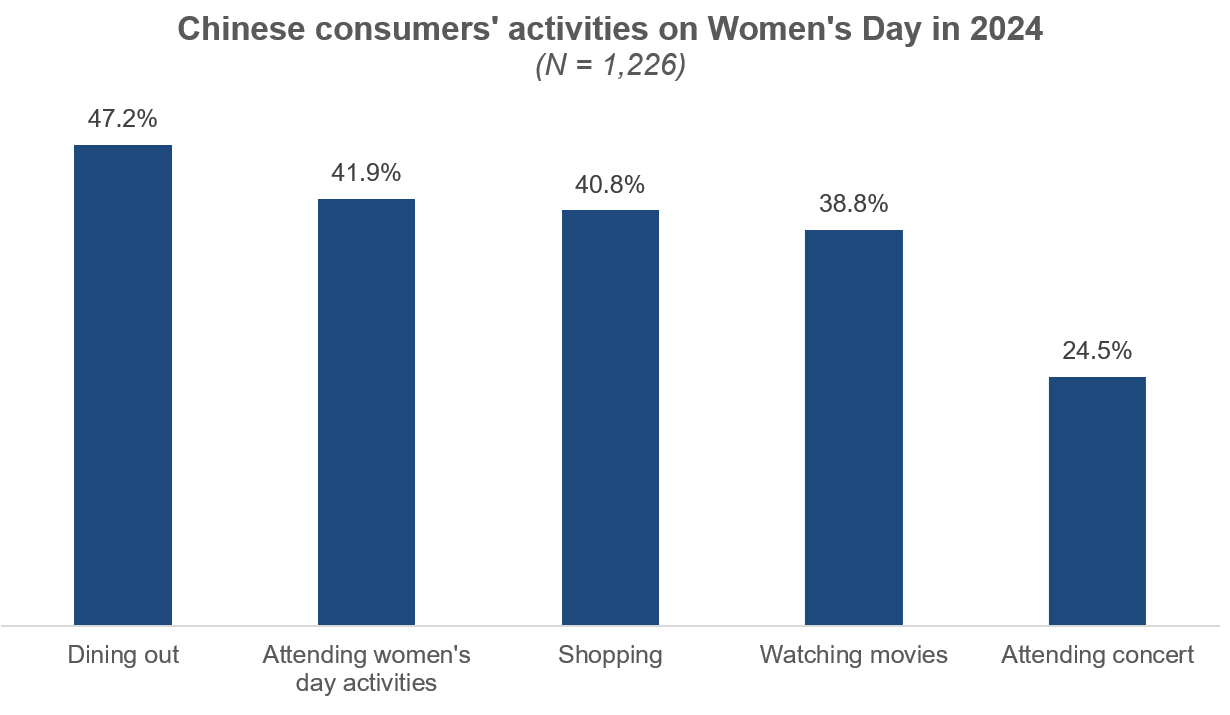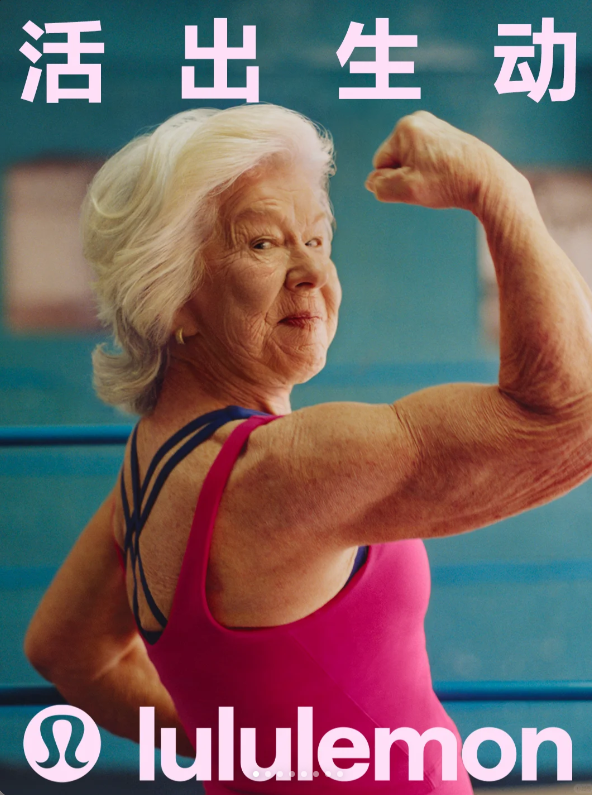Since the establishment of International Women’s Day in China in 1949, Chinese society has made tremendous progress in gender equality in many aspects, such as education, economic welfare, and social status. The recognition of Women’s Day in China has sparked women’s consciousness and protected many women oppressed by feudalism at that time. Today, Women’s Day inspires people to take action and promote social change to advance gender equality and women’s rights.
Download our report on the She Economy in China

Women’s empowerment and self-care
A 2024 survey of 1,226 respondents (mixed gender) found that 62.15% see International Women’s Day (三八妇女节) as a key occasion to celebrate women’s achievements and affirm their social status. Meanwhile, 51.06% of respondents feel that on this day, they experience care and recognition from all sectors of society, whether through special workplace benefits or broader societal attention to women’s rights.
The high percentage of women engaging in leisure activities like dining out, shopping, and attending events reflects their prioritization of self-care and happiness. This aligns with broader trends in China’s she-economy, where financially independent women, particularly millennials and Gen Z, are spending on themselves to enhance their quality of life. With nearly 400 million female consumers aged 20-60 driving annual spending of over RMB 10 trillion, China’s female consumer market became the third largest globally.

The continuance influence of the Sheconomy
The Sheconomy (她经济) continues to be a powerful driver of economic growth in China. Data shows that the female labor force participation rate in China was approximately 60.54% in 2024. This economic independence has translated into stronger purchasing power, making women a key demographic for brands.
The projected 4.8% compound annual growth rate (CAGR) in global female income outpaces the overall U.S. GDP growth rate of 2.4% in 2025. This widening gap highlights the increasing economic influence of women, which also presents vast opportunities for businesses that align with women’s priorities, such as self-care, sustainability, and empowerment.
Reclaiming the true spirit of Women’s Day
In recent years, Women’s Day in China has become heavily commercialized. E-commerce platforms and brands are using it as a marketing gimmick by promoting it as “Goddess Day” or “Queen’s Day.” These rebrandings were designed to appeal to younger women by emphasizing beauty, luxury, and consumerism, often sidelining the day’s original focus on women’s equality. Alibaba’s Tmall promoted “Queen’s Day” with slogans like “Live Your Beauty,” turning March 8 into a major shopping festival.
Since 2023, there has been a visible shift away from these commercialized labels toward reclaiming the term “妇女节” (Women’s Day). Many women feel that terms like “Goddess” or “Queen” trivialize their identities by focusing on external validation and consumption rather than substantive issues like rights and empowerment.
The word “妇女” (woman) was often avoided by younger generations due to its association with traditional roles like marriage and domesticity. However, feminist advocates argue that this rejection perpetuates stereotypes and undermines solidarity among women of all ages. Therefore, scholars and activists emphasize that Women’s Day should celebrate women’s achievements across political, economic, and social spheres rather than reducing it to a consumer event.
Ubras: Making the invisible discomforts visible
Ubras, a leading Chinese intimate apparel brand, has launched a powerful and thought-provoking campaign titled “Not Only Visible to Her” (不仅她可见). The campaign, encapsulated in a poignant short film, sheds light on the often-overlooked discomforts women face in their daily lives, particularly those caused by ill-fitting or poorly designed intimate wear.
Ubras uses this metaphor to draw attention to how these “invisible” issues often go unnoticed by society but are deeply felt by women. To address these challenges, Ubras has introduced its “Invisible Support Series” (隐形支撑系列), a new line of intimate wear designed to seamlessly blend comfort and support. The collection features innovative designs that conform to the natural curves of the female body, offering a “comfortable and supportive experience in every moment.”
The campaign goes beyond the realm of intimate apparel, acknowledging that women’s discomfort extends to many other aspects of daily life. From overly cold air conditioning in malls to car headrests positioned too high for the average woman’s height and the perpetually long lines for women’s restrooms, these are all examples of “invisible” challenges that disproportionately affect women. The campaign’s message is clear: women’s discomfort should no longer be invisible or dismissed as trivial. Ubras encourages women to break free from these constraints, listen to their inner voices, and embrace a life of freedom and self-expression.

Lululemon empowers women through movement
Lululemon’s “Live Like You Are Alive” (活出生动) campaign emphasizes women’s empowerment and age inclusivity by promoting the idea that movement is essential to living a vibrant and fulfilling life. The campaign encourages women to engage in various forms of physical activity, from running to yoga, as a way to celebrate their vitality and strength.
By showcasing individuals of different ages and life stages, the campaign challenges stereotypes about aging and promotes the idea that women can live actively and confidently regardless of their age. This aligns with Lululemon’s commitment to inclusivity and diversity in its messaging.
The “Live Like You Are Alive” campaign reflects shifting societal attitudes in China and globally toward women’s empowerment. It aligns with the growing Sheconomy by addressing women’s increasing focus on wellness, self-care, and experiential consumption. Furthermore, it supports International Women’s Day initiatives by encouraging women to celebrate their individuality through movement.

Why are these Women’s Day campaigns resonant in China?
With the rise of female empowerment, more women have gained and have begun to reject too much commercialization of Women’s Day and strive to restore Women’s Day in China to its original meaning. Women are now placing greater value on their abilities and strengths. They are breaking away from traditional definitions and seeking more recognition and support from society, particularly for marginalized and disadvantaged women.
Different professions and hobbies must be understood and supported by the public, with their talents and efforts acknowledged, especially by other women who may be struggling with self-doubt and societal pressures. These advertisements feature women from diverse backgrounds, showcasing their power and limitless potential in the simplest manner possible. These brands not only respect and understand women but also celebrate them. Female consumers may relate to these experiences or feel empowered by the brand’s acknowledgment and support of women, leading to a strong resonance.
Key takeaways from this article:
- Women’s Day in China has evolved from a holiday promoting gender equality to a mix of advocacy and recognition.
- Women continue to drive economic growth, contributing significantly to household income and making up a major consumer demographic in the beauty, fashion, and wellness industries.
- Women’s Day in China is shifting back to its roots. Once a holiday commercialized with “Goddess Day” and “Queen’s Day” marketing is aiming to restore its original focus on empowerment and rights.
- Ubras’ “Not Only Visible to Her” campaign highlights women’s overlooked discomforts, from ill-fitting intimate wear to broader societal inconveniences, advocating for greater awareness and solutions.
- Lululemon’s “Live Like You Are Alive” campaign empowers women through movement, challenging stereotypes about aging and promoting inclusivity.





